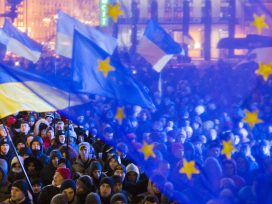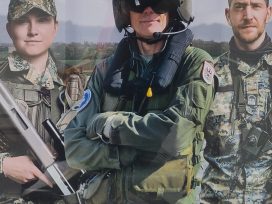As Ukrainian citizens of varying ethnic backgrounds continue to unite in resisting the Russian military onslaught, their identity as Ukrainians is perceived increasingly in terms that are civic, national and inclusive rather than pertaining to ethnic origin.
When planning his full-scale invasion of Ukraine, Vladimir Putin probably expected a welcoming or at least neutral response from the country’s ethnic Russian and Russian-speaking population. This expectation, shared by most people in the Russian Federation as well as many politicians and analysts in the West, was based on an entrenched perception of Ukraine as a multi-ethnic country with deep divisions between groups, particularly Ukrainians and Russians. According to this perception, Ukraine’s Russians are a minority distinct and distant from Ukrainians. Even Russian-speakers of other ethnic origins are seen as closer to Russians than to Ukrainian-speaking Ukrainians. Consequently, both Russians and Russian-speakers living in Ukraine are thought to be sympathetically disposed to Russia and opposed to the Ukrainian state’s pro-western and nationalizing policies.
The war has clearly demonstrated that this perception is false. It has proved to be nothing like the Russian leadership’s anticipated Blitzkrieg. Most Ukrainian citizens of all ethnic backgrounds have united in withstanding the Russian military onslaught, either on the battlefield or by supporting defensive action in other ways. Most impressively perhaps, people in the occupied cities of eastern and southern Ukraine – where Russian-speakers predominate – resolutely protested against the occupation for weeks, asserting unambiguously that their cities belonged to Ukraine as well as affirming their own identity as Ukrainians. This contrasted starkly with their subsequent enthusiastic response to the arrival of Ukrainian military, who were greeted as liberators in cities and villages retaken from the Russian army after fierce fighting. Although the full facts about life under occupation have not yet been established, it is obvious that few residents of these regions collaborated with the occupiers, while many – ethnic Ukrainians and Russians alike – were killed, tortured, raped, or deported to Russia.
Ukraine’s Russians and Russian-speakers are neither distant from Ukrainians nor friendly towards Russia. They are an integral part of the Ukrainian civic nation. This integration was facilitated by the Russian aggression of 2014 and, more obviously, by that of 2022 – but it stems primarily from inconspicuous developments of three decades of Ukrainian independence. Despite a Soviet legacy of strongly institutionalized ethnic identity, the post-Soviet Ukrainian state discontinued or downplayed most institutional mechanisms enabling the reproduction of ethnic distinctiveness. It also virtually abandoned the use of ethnic categories in official discourse. While some smaller groups retained a discursive presence of their own, the once dominant minority of ethnic Russians ceased to be publicly presented and popularly perceived as distinct from the bulk of Ukrainians. This change was manifested most vividly in a broad reassignment of the group’s ethnic label to the population of Russia, which is now accepted both in elite-controlled discourses and in the everyday communication of ordinary people.
The Soviet legacy
The Soviet regime made ethnicity a fundamental social category and presented multiethnicity as a defining feature of society. Indeed the state itself was multi-ethnic since, formally, the USSR was a federation of fifteen supposedly national republics, with some of these incorporating lower-level autonomous units for smaller groups. In addition to such territorial institutionalization, ethnicity was institutionalized on a personal level. Every citizen was assigned a fixed, supposedly descent-based ‘nationality’, which the regime made virtually unchangeable, registered in personal documents, and used in many practices of positive or negative discrimination.
Obviously, state policies changed with time and varied across groups. In the 1920s and the early 1930s, the Soviet leadership actively promoted the institutionalization of countless ethnic categories, transforming their putative members into distinct groups with their own designated political bodies and/or cultural facilities. In the mid-1930s, however, the regime reduced the number of recognized ethnic groups, disbanded territorial units and cultural establishments for many of those still recognized, introduced discrimination against putative members of some non-Russian groups, and elevated the Russian nation to the status of ‘first among equals’. It established Russian-language educational and cultural facilities throughout the USSR and gave highest priority to the linguistic needs of Russians (and, by extension, people of other ethnic origin who had been Russified). However, the existence of national communities with their own cultural and political identities was never in doubt.
At the same time, some long-term Soviet policies weakened ethnic boundaries by undermining many people’s identification with their assigned nationality. Due to large-scale internal migration, millions of Soviet citizens found themselves in republics or autonomies other than ‘their own’, which created a discrepancy between the territorial and personal dimensions of their ethnic identity. After the regime shut down all educational and cultural facilities in languages other than a republic’s titular language and Russian, members of non-Russian minorities could no longer support their ethnic identity by practising their languages and cultures. Many thus came to identify with the Russian or Soviet people no less strongly than with their putative ethnic group. In the decades following World War II, linguistic Russification became increasingly widespread in non-Russian republics, particularly in big cities where migrants from other republics constituted a sizeable part of the population and Russian was the predominant language of both prestigious jobs and popular culture. While a continuous influx of people from the countryside increased the numbers of titulars in most cities’ populations, over time many rural migrants switched to using Russian as the main language of their everyday lives. The change of language did not usually lead to a change of nationality, however: this was considered to be determined by the nationality of one’s parents. At the same time, the increasing prevalence of ethnically mixed marriages encouraged mixed offspring to select a single nationality that often failed to reflect their self-identification, which further blurred the boundaries between different groups.
Ukraine was one of the republics where such boundary-blurring tendencies were most pronounced. It saw in-migration from Russia on a mass scale, with the majority of newcomers settling in cities where the share of ethnic Russians thus reached 30%. Accordingly, most factories, offices, educational establishments, and cultural facilities in cities relied on Russian, which in turn spurred native speakers of Ukrainian and other languages to use this as their main language. While most ethnic Ukrainians retained their self-designation by nationality, the gap between ethnic and linguistic identifications grew ever wider. Daily reliance on Russian was even more widespread than identification with it as one’s native language. The discrepancy between ethnolinguistic identification and language practice weakened many people’s attachment to their alleged groups. Moreover, the use of the same language by most urban residents of Russian and Ukrainian descent further blurred the inter-group boundary. Finally, the boundary was further undermined by increasing numbers of ethnically ‘mixed’ marriages which accounted for up to 30% of marriages by 1979, with numbers particularly high in eastern and southern regions.
De-institutionalized ethnicity
The demotion of ethnicity in post-Soviet Ukraine resulted from boundary-making efforts of influential political actors and the state whose institutions they controlled. The decreasing importance of ethnic distinctions is best highlighted with reference to three straightforward criteria: their entrenchment by state institutions; their prominence in political discourse; and their salience for the population.
The design of institutions regulating the inclusion of ethnic groups into the newly independent political community and the expression of their distinctiveness was intended to ensure the population’s support in the referendum that legitimized Ukraine’s independence in December 1991. Like most other former Soviet republics, Ukraine granted automatic citizenship to all people then permanently residing on its territory. It was also among the post-Soviet states that did not privilege members of the titular ethnic category in acquiring citizenship through immigration and naturalization. As far as the recognition of ethnic rights was concerned, the Ukrainian state sought to combine the legacy of the Ukrainian Soviet republic and the normative approaches of the European organizations to which it wished to belong. Soon after the proclamation of independence, parliament adopted a law on national minorities that recognized their right to meet their linguistic, cultural and religious needs. However, ambiguity in the wording of the provision exempted the state from any obligation to ensure adequate means to implement the declared right.
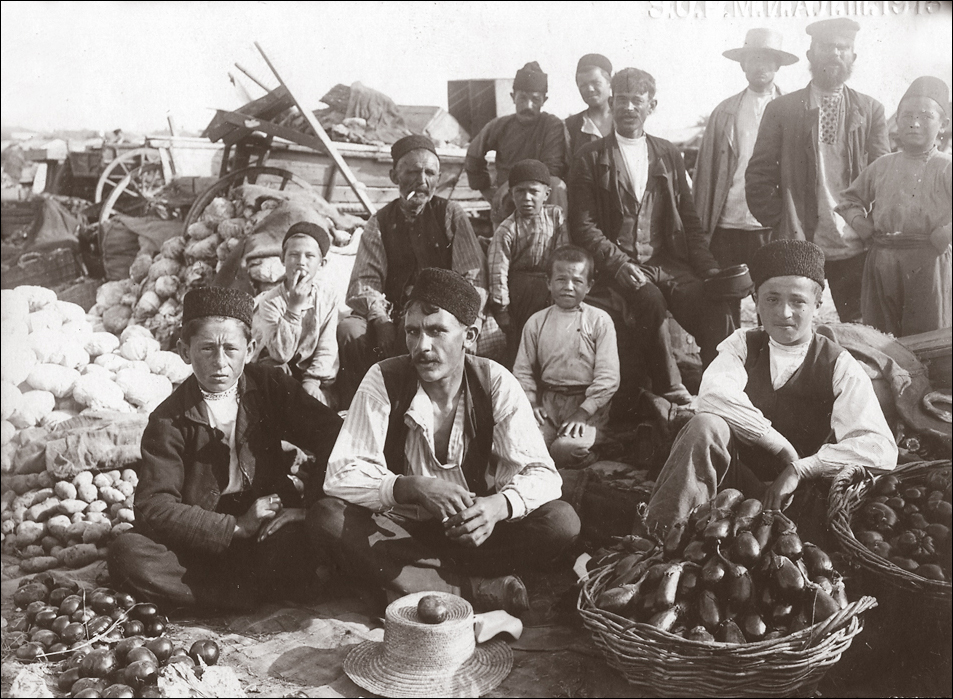
An old photo of Crimean Tatars selling vegetables, Russian Museum of Ethnology. Source: Wikimedia Commons.
At the same time, the Ukrainian leadership refrained from recognizing the right of minorities to territorial autonomy, which was considered dangerous for the new state’s territorial integrity. The only territorial autonomy within Ukraine, Crimea, was established in the last year of the USSR’s existence. This occurred in the context of the alleged restoration of autonomies abolished during the Stalin years. Although the autonomy’s ethnic character was not explicitly recognized, both the Russian majority and the Crimean Tatar minority were given the right to use their languages in various domains (however, for the minority, this right remained mostly symbolic). The Ukrainian authorities’ negative attitude to ethnically based political organizations was reflected in a law on political parties, which stipulated that a party could be established only with the support of citizens from at least two thirds of Ukraine’s oblasts. This precluded the formation of parties by ethnic minorities concentrated in certain regions. Russians were the only minority that had a significant, albeit uneven, presence in all oblasts, but influential politicians of Russian descent were more interested in joining (or establishing) parties that would gain support among all major ethnic groups.
Finally, the post-Soviet Constitution of 1996 defined ‘the people of Ukraine’ – the political community on whose behalf the act was adopted – as ‘Ukraine’s citizens of all nationalities’ and recognized particular rights for national minorities and indigenous peoples. However, the wording of the Constitution reflected the logic of establishing an independent state from a former Soviet republic, rather than signalling a dominant approach to governing that state. In the years that followed, ethnic references in legislative and administrative acts became increasingly rare. While the authorities declared that ethnic discrimination was unacceptable and did not usually prevent members of ethnic minorities from assuming representative or executive positions, they wanted them to act as representatives of their territorial constituencies rather than their ethnic groups. Such an approach contributed to the low salience of the previously assigned ethnic identities for members of most ethnic categories – except for those whose identities were sustained by the experience of collective action or special treatment on the basis of ethnicity (particularly Crimean Tatars, Hungarians and Roma).
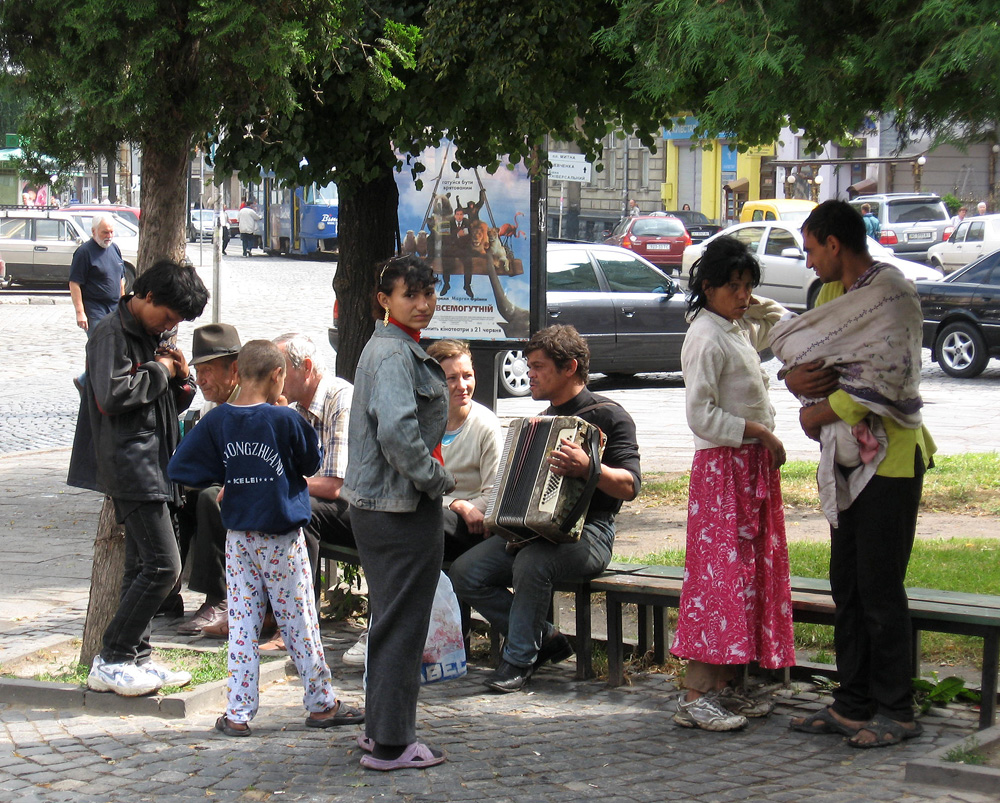
Romani people in Lviv, Ukraine. Author: Водник. Source: Wikimedia Commons.
The fact that the new state discontinued the Soviet practice of officially registering personal nationality also contributed to the low salience of ethnic identity. Consequently, the authorities did not know the nationality of citizens they were dealing with and could not use it for preferential or discriminating treatment, except when it could be inferred from appearance or speech. In most parts of the country, Ukrainians and Russians were indistinguishable. At the same time, the absence of information on individuals’ nationality presented no challenge to the time-honoured belief in the importance of this characteristic. This was made evident by the inclusion of a question on nationality in the first post-Soviet census of 2001. The influence of this Soviet practice was undermined, however, by the authorities’ refusal to conduct another census after the usual gap of about ten years or thereafter. The prolonged absence of up-to-date statistics on the numerical strength of ‘nationalities’ contributed to the virtual disappearance of ethnic categories from public discourse, which, in turn, further downplayed their perceived social relevance. Some minorities such as Hungarians or Crimean Tatars remained visible thanks to their activities or special treatment by the Ukrainian authorities or by the governments of their kin-states. In contrast, the largest non-titular category, the Russians, was activated neither by its putative members nor by political actors in Ukraine or Russia.
Linguistic differences between members of the Ukrainian and Russian categories were more visible and entrenched than ethnic ones. Since the early years of independence, the language issue remained salient in Ukrainian politics as supporters of Ukrainian sought to overcome the legacy of Soviet Russification, while parties claiming to represent speakers of the Russian language fought for its unrestricted use in all domains. Yet linguistic boundaries were not strongly institutionalized either. Although the 1996 Constitution assured the ‘free development, use and protection of Russian, and other languages of national minorities of Ukraine’ alongside Ukrainian as the sole state language, it did not indicate any specific means for the enactment of this guarantee. An individual’s language preference was not recognized as a basis for claiming linguistic rights. The discrepancy between language identity and language practice, which makes it impossible to unequivocally distinguish between speakers of the two main languages, further undermined linguistic boundaries – all the more so because many people identify with or rely on both Ukrainian and Russian. Nonetheless, language preference remains a more pronounced social marker than ethnic identity. It is also a more divisive political issue.
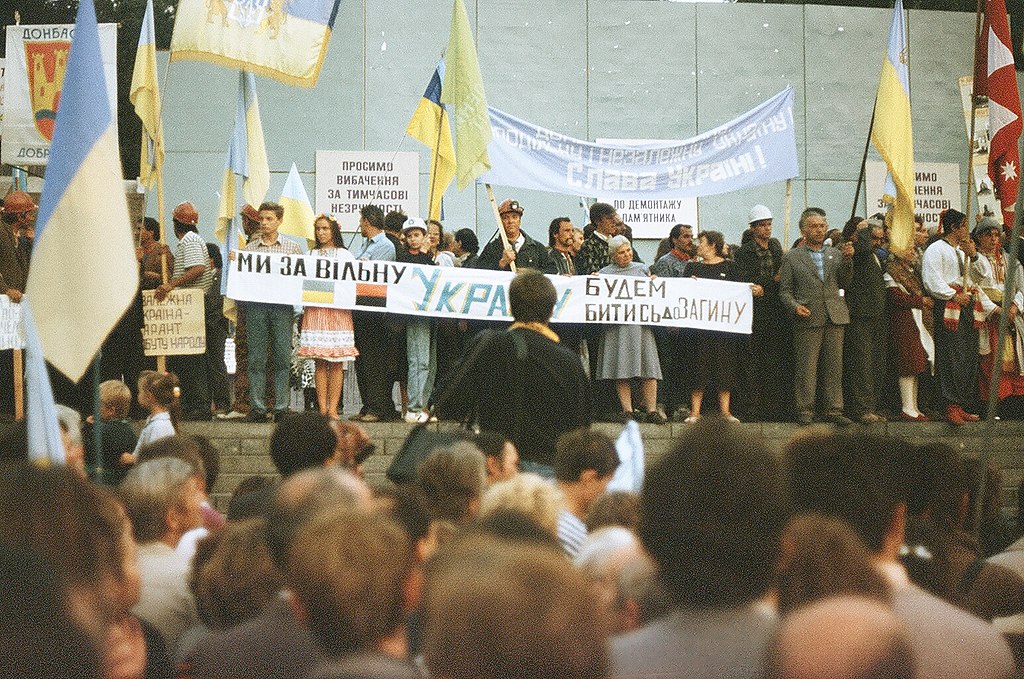
Rally on Maidan Nezalezhnosti, 1990. Author: М.Яковенко, В.Білецький. Source: Wikimedia Commons.
Citizens’ identifications
Survey data confirms the lower salience of ethnic identity compared to national attachment, and a shift in the meaning of Ukrainian identity from ethnic to ethnonational. Major poll companies regularly ask respondents what their nationality ‘is’ or who they ‘consider themselves to be’. However, they do not usually include responses to this question in their press releases which are the main source of public knowledge about the attitudes and preferences of the population. The few results that have been published demonstrate a steady increase, over the years, of the percentage of respondents who declare their nationality to be Ukrainian. There is also a corresponding decrease in the share of those identifying as Russian. Surveys where respondents are allowed to declare not just ‘clear-cut’ identities but also a ‘hybrid’ Russian-Ukrainian one, demonstrate that many people have a sense of being both Ukrainian and Russian.
Further blurring the boundary between the two nationality ‘groups’ is the fact that many people who opt for one nationality category, when they feel it’s expected of them, still also identify with the other. In the regular omnibus surveys by the Kyiv International Institute of Sociology (KIIS), for example, a question on respondents’ nationality is followed by another question asking those who identified as Ukrainian, Russian, or both to locate their identity on a five-point scale between the two ‘pure’ categories. In 2017, 10% of respondents who initially chose Ukrainian nationality also reported some degree of Russianness, and an impressive 55% of those opting for Russian nationality admitted an additional identification as Ukrainians. It may be assumed that for people of Russian origin who have come to feel Ukrainian, the latter identity primarily has a civic meaning (ethnographic research in various parts of the country appears to confirm this assumption). When surveys enquire about the meaning of ‘Ukrainianness’ without connecting it to the category of nationality, respondents clearly prioritize civic or attitudinal criteria over ethnocultural ones. In 2020, another KIIS survey asked respondents what characteristic ‘is the most important for telling who is really a Ukrainian and who is not’, giving them the choice between two ethnic and two civic criteria. The responses confirmed a clear preference for the civic understanding of Ukrainianness. While 45% of respondents prioritized Ukrainian citizenship and 25% highlighted permanent residency in the country, only 9% defined ‘Ukrainianness’ primarily by descent and 6% by use of the language.
Surveys also suggest that Russian ethnic identity is much less salient for respondents than Ukrainian identity which is both ethnic and national. In 2014, KIIS respondents were given a list of twenty different characteristics and asked to indicate up to three that best described them. The responses confirmed that ‘Ukrainian’ (highlighted by 47% of those surveyed) was a much more salient characteristic than ‘Russian’ (3%) or ‘Russian-speaker’ (4%). This does not necessarily mean that Ukrainian ethnicity matters more than Russian ethnicity – although it may be the case because of the much greater discursive prominence of the former. Rather, Ukrainian identity matters more than Russian identity because the former is national as well as ethnic. This is confirmed by the fact that, in the survey, 9% of Russians by nationality also considered ‘Ukrainian’ as one of their best fitting characteristics – which indicates that they perceived Ukrainian identity as primarily civic and thus compatible with their ethnic identification as Russians.
Ethnocultural diversity
The widespread perception of Ukraine as a multi-ethnic country with clear-cut boundaries between ethnic groups is evidently inadequate. While some ethnic minorities remain distinct, the boundary between people formerly categorized as Ukrainians and Russians has all but disappeared. Its dilution began in the Soviet period when people of different origin came to be mixed and cities linguistically Russified. But it is the post-Soviet abandonment of institutional and discursive mechanisms for the reproduction of ethnic distinctions that contributed crucially to the low salience of ethnic identities. Institutions that had once maintained a boundary between the two main ethnic categories became inoperative; ethnic Russians were virtually erased from public discourse; and, over the years, most people of Russian descent ceased to identify as Russians or to attach importance to that lingering identity. While Ukrainian identity has become preeminent, it is now primarily perceived not as pertaining to a particular ethnic group but as an encompassing national identity of the entire population. Responses to the Russian aggression of 2014, and particularly to the full-blown invasion in February 2022, vividly confirmed this – but the above analysis reveals that changes in patterns of identification by the would-be ethnic categories and the meaning people attached to them began much earlier. Disagreements about the content of Ukrainian identity persist, but these are no longer seen in terms of confrontation or competition between different ethnic groups.
While Ukraine’s multi-ethnicity is disappearing as the coexistence of distinct ethnic groups, it persists as the diversity of ethnocultural practices and ethnolinguistic identifications. Few people living in Ukraine today view themselves as exclusively Russian, but many consider Russian their native language. Still more use Russian in their daily lives. Numerous others combine Ukrainian and Russian elements in their linguistic and cultural repertoires. Finally, there are people who identify with other categories and practice other languages and cultures. There can be no doubt that Ukraine is ‘ethnoculturally diverse’ – which seems a considerably more fitting designation than the traditional label ‘multi-ethnic’.
Published 10 February 2023
Original in English
First published by Eurozine
© Volodymyr Kulyk / IWM / Eurozine
PDF/PRINTIn collaboration with
In focal points
- Not epistemic enough to be discussed
- Another lost generation of art?
- A trace of Russia at the heart of Austria
- What makes a humanist kill?
- Something happens, somewhere
- Vertical occupation
- No longer a footnote
- The Ides of March
- Counteroffensive exhibitions
- No peace without freedom, no justice without law
Newsletter
Subscribe to know what’s worth thinking about.
Related Articles
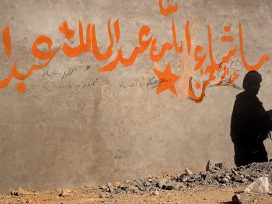
From Bosnia to Afghanistan, the neoliberal peace-building model has compounded conflicts and inequalities by eroding the core function of states. But in Ukraine, the co-optation of the recovery process by private economic interests is being taken to a whole new level.

Artist Marharyta Polovinko’s creativity persisted in a tormented form through her experiences as a soldier on the Ukrainian frontline. The words of a recently called-up fellow creative and young family man provide a stark reminder that the Ukrainian military is buying Europeans time.

